Do you have a question about the Orion StarBlast II 4.5 EQ and is the answer not in the manual?
Ensuring smooth movement of the telescope on both axes of the equatorial mount by proper balancing.
How to achieve sharp focus on celestial objects using the focuser.
Tips for observing while wearing eyeglasses and dealing with astigmatism.
How to use the EZ Finder II reflex sight for aiming the telescope.
Instructions for inserting the CR2032 battery into the EZ Finder II reflex sight.
Aligning the equatorial mount with the Earth's rotational axis for tracking celestial objects.
How to use slow-motion cables for fine adjustments of telescope position.
How to keep celestial objects in the field of view using the R.A. slow-motion control.
Explanation of R.A. and Dec. setting circles for locating celestial objects by coordinates.
Procedure to calibrate the R.A. setting circle for accurate object location.
Steps to locate celestial objects using calibrated setting circles and the reflex sight.
Description of tools used for collimating: collimating cap and primary mirror center mark.
Procedure to adjust and center the secondary mirror for proper optical alignment.
Procedure to adjust the primary mirror tilt to center the reflection of the secondary mirror.
Using star tests to determine if the telescope optics are accurately aligned.
Tips for selecting an optimal location for observing celestial objects.
Understanding atmospheric conditions affecting image quality and visibility.
Importance of allowing the telescope to reach thermal equilibrium before observing.
The process and importance of dark-adapting your eyes for better night vision.
How to choose and use different eyepieces to achieve various magnifications.
What celestial objects can be observed and what to expect visually.
Tips for observing the Moon, including best phases and using a Moon filter.
Information on observing planets and how to find them using charts.
Warning about observing the Sun and methods for safe daytime viewing.
Observing stars, including double stars and their colors.
Guidance on observing faint deep-sky objects under dark skies.
Instructions for cleaning telescope eyepieces and mirrors, and precautions.
Ensuring smooth movement of the telescope on both axes of the equatorial mount by proper balancing.
How to achieve sharp focus on celestial objects using the focuser.
Tips for observing while wearing eyeglasses and dealing with astigmatism.
How to use the EZ Finder II reflex sight for aiming the telescope.
Instructions for inserting the CR2032 battery into the EZ Finder II reflex sight.
Aligning the equatorial mount with the Earth's rotational axis for tracking celestial objects.
How to use slow-motion cables for fine adjustments of telescope position.
How to keep celestial objects in the field of view using the R.A. slow-motion control.
Explanation of R.A. and Dec. setting circles for locating celestial objects by coordinates.
Procedure to calibrate the R.A. setting circle for accurate object location.
Steps to locate celestial objects using calibrated setting circles and the reflex sight.
Description of tools used for collimating: collimating cap and primary mirror center mark.
Procedure to adjust and center the secondary mirror for proper optical alignment.
Procedure to adjust the primary mirror tilt to center the reflection of the secondary mirror.
Using star tests to determine if the telescope optics are accurately aligned.
Tips for selecting an optimal location for observing celestial objects.
Understanding atmospheric conditions affecting image quality and visibility.
Importance of allowing the telescope to reach thermal equilibrium before observing.
The process and importance of dark-adapting your eyes for better night vision.
How to choose and use different eyepieces to achieve various magnifications.
What celestial objects can be observed and what to expect visually.
Tips for observing the Moon, including best phases and using a Moon filter.
Information on observing planets and how to find them using charts.
Warning about observing the Sun and methods for safe daytime viewing.
Observing stars, including double stars and their colors.
Guidance on observing faint deep-sky objects under dark skies.
Instructions for cleaning telescope eyepieces and mirrors, and precautions.
| primary mirror diameter | 114 mm |
|---|---|
| effective focal length | 450 mm |
| focal ratio | f/3.9 |
| minor axis of secondary mirror | 34 mm |
| eyepiece diameter | 1.25 inches |
|---|---|
| eyepiece magnification with 25mm eyepiece | 18x |
| eyepiece magnification with 10mm eyepiece | 75x |
| total instrument weight | 17 lbs |
|---|---|
| mount type | EQ-1, German equatorial |
| tripod material | Aluminum |
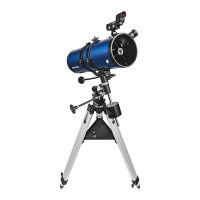
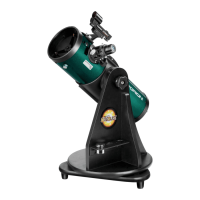

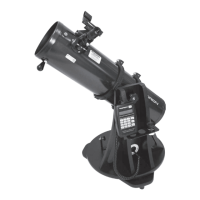

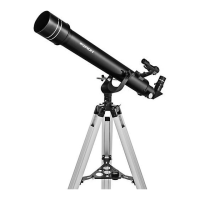
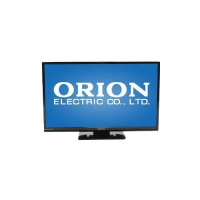
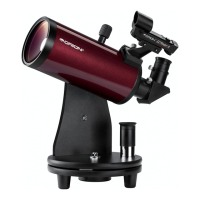


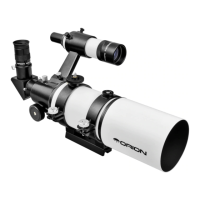
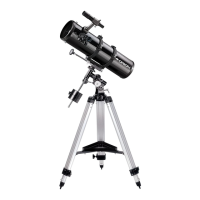
